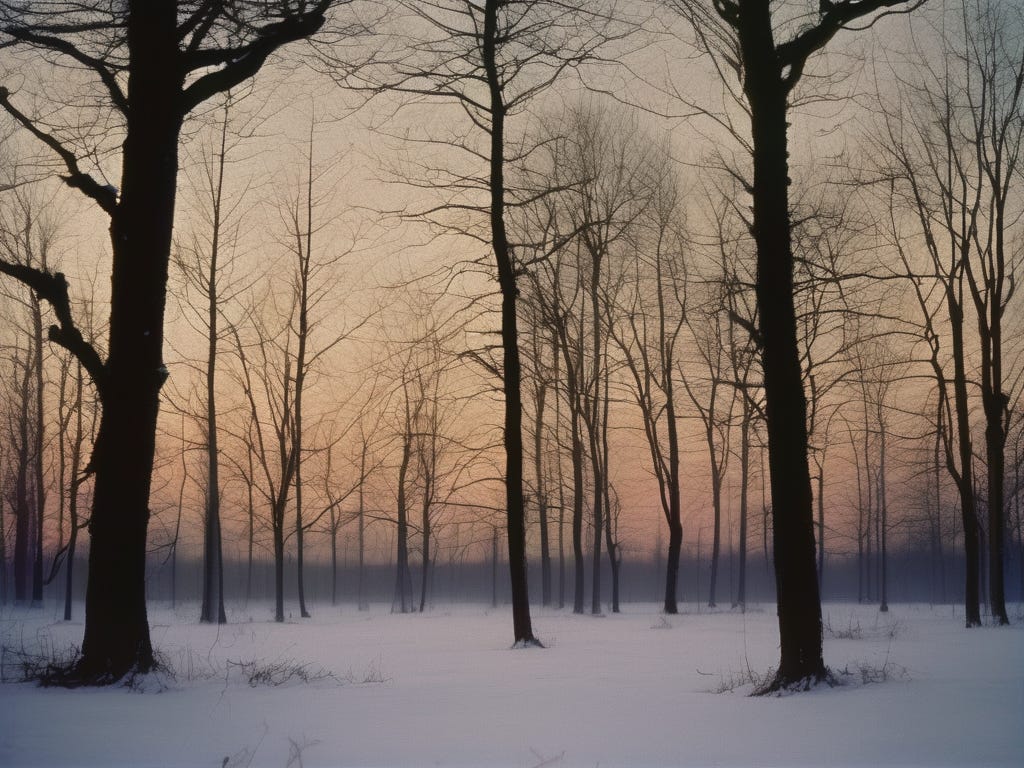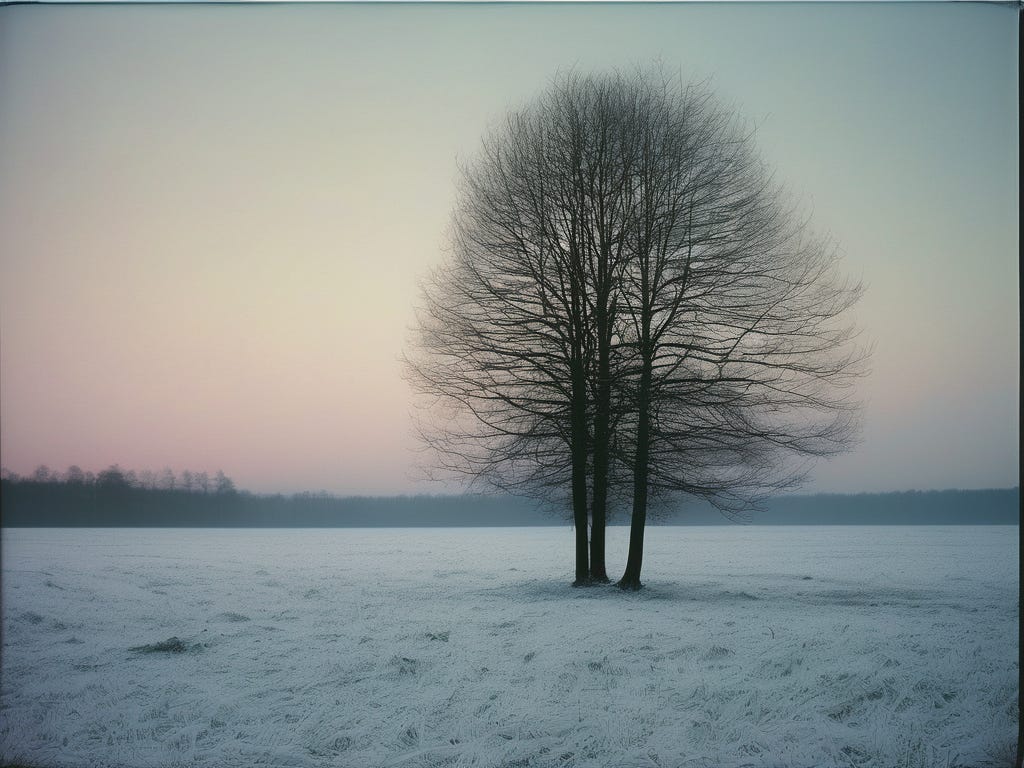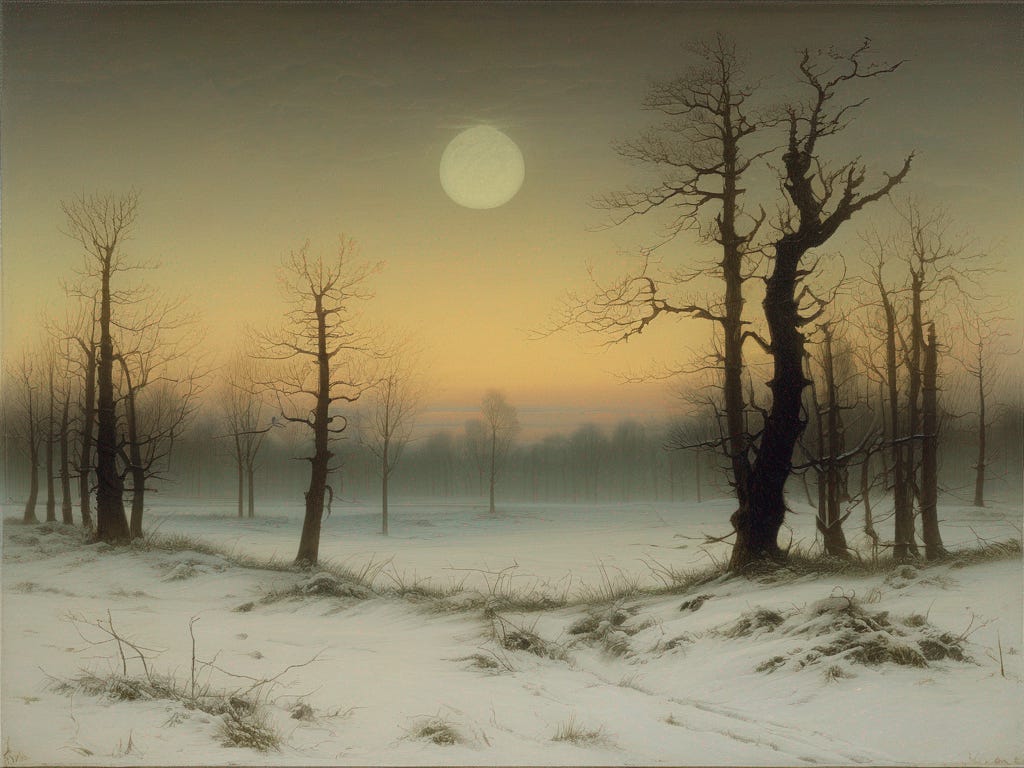Sunless Solstice: Strange Christmas Tales for the Longest Night (2021) edited by Lucy Evans and Tanya Kirk
Varieties of spectral Yuletide fiction
Readers unfamiliar with Sunless Solstice: Strange Christmas Tales for the Longest Night may prefer to read these notes only after reading the anthology.
Sunless Solstice: Strange Christmas Tales for the Longest Night (2021) edited by Lucy Evans and Tanya Kirk is another British Library anthology focused on the holiday season. In the introduction, the editors write:
[....] with this third entry of festive ghost stories in the Tales of the Weird series we also bring together some less traditional tales with a wintry theme. The winter solstice, considered so significant in many cultures, brings the shortest day of the year and the extreme of winter. The symbolic death and rise of the sun and the hope that comes with longer days is a fitting time for a ghost story. The tales featured in this collection present the very height of the season, from a snowy mountain ascent to a chilling encounter on the ice.
The stories in this collection, presented in chronological order, were published from 1893 to 1974 and feature some writers who may be immediately familiar….
The stories break down chronologically into three periods: three stories from the 19th Century, four stories from the inter-war period, and five from the post-1945 period. Those eighty-one years were eventful: in the UK, the period saw the rise of Labour, the Boer War, economic crises, two world wars, victorious anti-colonial struggles, and the development of a mass women's rights movement. The period also saw an expansion of mass circulation magazines carrying short stories, and then their contraction.
19th Century
"The Ghost at the Cross-Roads: An Irish Christmas Night Story" (1893) by Frederick Manley is framed with a substantial account of family and friends celebrating the holiday in an isolated rural home, before the protagonist arrives out of the snow. His anecdote about a terrifying crossroads encounter has all the folk horror hallmarks.
"The Blue Room" (1897) by Lettice Galbraith is a compelling story. It covers nearly a century in the evil career of a room fatal to young women. Our narrator is Mrs. Marris, head housekeeper at Mertoun Towers. She relates how, near the end of her career, a young woman guest at the Towers commits to besting the Blue Room and eradicating its deadly activity.
I did my best to comfort him, saying Miss Erristoun wouldn’t come to any harm; but it wasn’t a bit of use, for I didn’t believe in my own assurances. I felt nothing but ill could come of such tempting of Providence, and I seemed to see that other poor girl’s terrible face as it had looked when we found her dead in that wicked room. However, it is a true saying that ‘a wilful woman will have her way,’ and we could do nothing to prevent Miss Erristoun’s risking her life; but I made up my mind to one thing, whatever other people might do, I wasn’t going to bed that night.
Galbraith patiently and richly builds an upstairs-downstairs world that the horror intermittently disrupts. It is an outstanding story, and deserves more attention.
"On the Northern Ice" (1898) by Elia W. Peattie is a brief tale of devotion and supernatural deliverance. It eloquently depicts life in northern Michigan, near Sault Ste. Marie.
The Inter-War
"The Black Cat" (1921) by W. J. Wintle is a graceful horror story about a phobia that finds a ready target.
.....the possession of ample means, an inherited dislike for any kind of work calling for energy, and two or three interesting hobbies which filled up his time in an easy and soothing fashion, left him free to indulge his fancies. And fancies, when indulged, are apt to become one’s masters in the end; and so it proved with Sydney.
He was engaged in writing a book on some phase of Egyptian life in the olden days, which involved considerable study of the collections in the British Museum and elsewhere, as well as much search for rare books among the antiquarian bookshops. When not out on these pursuits, he occupied an old house which like most old and rambling places of its kind was the subject of various queer stories among the gossips of the neighbourhood. Some tragedy was supposed to have happened there at some date not defined, and in consequence something was supposed to haunt the place and to do something from time to time. Among local gossips there was much value in that nebulous term ‘something’, for it covered a multitude of inaccurate recollections and of foggy traditions. Probably Sydney had never heard the reputation of his house, for he led a retired life and had little to do with his neighbours. But if the tales had reached his ears, he gave no sign; nor was he likely to do so. Apart from the cat obsession, he was a man of eminently balanced mind. He was about the last person to imagine things or to be influenced by any but proved facts.
"Ganthony's Wife" (1926) by E. Temple Thurston is a richly imagined anecdote, with an introductory framing device that absorbs half the tale's length. It begins at a house party, late in the evening.
It was Mrs Stenning who opened the discussion by complaining that there was no one qualified to tell children ghost stories nowadays.
Another guest, Mr. Northanger, says he has a story, one not suitable for children. And so Northanger begins framing his spectral anecdote, concerning his friend Ganthony, a tea planter in Ceylon. By now Thurston has the reader tucked deeply into the Russian nesting doll structure of his plot, and we savor every moment as we learn about the eccentricities of Ganthony's wife. Eccentricities experienced both before and after her death out east.
"Mr Huffam" (1933) by Hugh Walpole pulls out all the stops to be twee and charming about Christmas under its pall of Dickensianism. Walpole celebrates every cliché, yet ripens them with engaging particularity. Mr. Huffam brings magic and joy to the stuffy and straightlaced Winsloe household, puncturing their bourgeois shell for a time. Huffam is not a spook or doppelganger; he moves in the waking world and touches many. Ultimately, we may feel that Walpole over-eggs the pudding. But in the process he brings to life several lively and uncanny episodes.
"The Man Who Came Back" (1935) by Margery Lawrence is a fantastically suspenseful and dread-full story. It begins with dinner party cross-talk and acute social observation. Then the hostess announces they are going to enjoy a seance with a professional medium. Not all guests are thrilled.
‘Are you going to be at the sitting?’ [Madame Esperanza] asked.
Her voice was reedy, and she spoke with a faintly uneducated twang. Ida Playfair regarded her with a slight sense of distaste mingled with wonder and a rising sense of incredulity. Surely nothing that this common, shabby little woman could say could be really worth while! Probably as Ned declared, she was just a clever poseuse, some back-street pythoness who had somehow managed to impress dear old Thedosia Garrison—but quite obviously nobody to feel afraid of. She laughed breezily.
‘Certainly I am! I’m not going to miss shaking hands with a spook!’
The medium looked down at her in silence. Behind, the room was in a cheerful uproar as chairs were hastily arranged in a circle, tables, cushions and whatnots pushed into corners, the door locked and a length of scarlet silk draped over the chandelier to dim its brightness to the requisite subdued glow; Lady Garrison, in her element, was bustling about directing operations, and for the moment the three beside the fire were alone, unnoticed, the shabby little woman with the intent eyes and the handsome young doctor and his wife. As if hypnotized by that strange, steady stare, for a moment Ida stared back without speaking—then Madame Esperanza spoke, suddenly and decidedly.
‘I wouldn’t, if I were you,’ she said….
Madame Esperanza's advice is well-founded. Margery Lawrence creates a superbly detailed occult atmosphere, one to rival her story "The Haunted Saucepan," which I wrote about here.
Post-1945
"The Third Shadow" (1950) by H. Russell Wakefield is told as an after-dinner discussion between two men. They compare notes about the fate of their mutual friend, Brown. Brown did not marry wisely, or well.
Wakefield rivals Waugh in depicting marriage with arch distance:
.....Technically, he was a master in all departments, a finished cragsman and just as expert on snow and ice. But there was just occasionally an un-mastered streak of recklessness in him which flawed him as a leader, and everyone, including myself, preferred to have him lower down the rope.
‘It was, perhaps, due to one of these reckless seizures that, after our fourth season together, he proposed to a wench, who replied promptly in the affirmative. He was a smallish fellow, though immensely lithe, active, strong and tough. She was not far short of six feet and tipped the beam at one hundred and sixty-eight pounds, mostly muscle. With what suicidal folly, my dear Bill, do these infatuate pigmies, like certain miserable male insects, doom themselves with such Boadiceas, and how pitilessly and jocundly do those monsters bounce upon their prey! This particular specimen was terribly, viciously, “County,” immensely handsome, and intolerably authoritarian. Speaking evil of the dead is often the only revenge permitted us and I have no intention of refraining from saying that I have seldom, almost certainly never, disliked anyone more than Hecate Quorn. Besides being massive and menacing to the nth degree, she was endowed with a reverberating contralto which loaned a fearsomely oraculate air to her insistent spate of edicts. Marry for lust and repent in haste, the oldest, saddest lesson in the world, and one my poor friend had almost instantly to learn. Once she’d gripped him in her red remorseless maw, she bullied him incessantly and appeared to dominate him beyond hope of release. Such an old story I need enlarge upon it no more! How many of our old friends have we watched fall prostrate before these daughters of Masrur!
Brown eventually determines how to free himself from the wonderfully named Hecate Quorn. Alas, easier said than done.
"The Apple Tree" (1952) by Daphne du Maurier is a queer story about the aftermath of a woeful marriage. Du Maurier imagines the daily events of a widower, his sense of freedom after the death of his wife, who lived for decades in self-inflicted domestic martyrdom. The husband imagines various ways a man might be happy: with friends at the pub, with a Land Girl met during the war, and:
....The ideal life, of course, was that led by a man out East, or in the South Seas, who took a native wife. No problem there. Silence, good service, perfect waiting, excellent cooking, no need for conversation; and then, if you wanted something more than that, there she was, young, warm, a companion for the dark hours. No criticism ever, the obedience of an animal to its master, and the light-hearted laughter of a child. Yes, they had wisdom all right, those fellows who broke away from convention. Good luck to them.
"The Apple Tree" is a powerful depiction of the self-indulgence older men think they'll enjoy. All the options, all the follies and misadventures, lead but to the grave.
"The Leaf-Sweeper" (1956) by Muriel Spark should not be confused with A. M. Burrage's 1931 story "The Sweeper." Not that a reader who has enjoyed both the Burrage and Spark stories could ever confuse them.
"The Leaf-Sweeper" begins as a reminiscence about a young eccentric who wants to abolish Christmas. Ultimately, he is sent to an asylum. But what may be his doppelganger is not confined, and it loves Christmas. The narrator has a hard time determining which entity is more horribthem.
It sounds hard. But perhaps you don’t know how repulsive and loathsome is the ghost of a living man. The ghosts of the dead may be all right, but the ghost of mad Johnnie gave me the creeps.
Triangulated somewhere between Dahl, Aickman, and Ramsey Campbell, "The Leaf-Sweeper" is a terrifying delight.
"The Visiting Star" (1952) by Robert Aickman is the third or fourth Aickman story I have read. It's criminal self-neglect, I know. Aickman's prose is perfectly turned. I laughed out loud each time he reminded us his protagonist Colvin was staying in the story's benighted town to research a book on "lead and plumbago mining." Plumbago is a very funny word.
Colvin's encounters with the odd Mr. Superbus, titular Arabella Rokeby, and Emancipation Hotel manager Mrs. Royd (another very funny word), among others, quickly become a fun-house boutade. At first the situation is akin to “Fawlty Towers” if rewritten by Pemberton and Shearsmith. Dread mounts, however, until we reach the moment of shocking revelation, during a plumbago mine tour at nightfall.
‘What’s that?’ enquired Miss Rokeby when they had none the less reached the extremity of the passage.
‘It’s a big fault in the limestone. A sort of cave. The miners chucked their débris down it.’
‘Is it deep?’
‘Some of these faults are supposed to be bottomless.’
She took the light from his hand, and, squatting down on the brink of the hole, flashed it round the depths below.
‘Careful,’ cried Colvin. ‘You’re on loose shale. It could easily slip.’ He tried to drag her back. The only result was that she dropped the flashlight, which went tumbling down the great hole like a meteor, until after many seconds they heard a faint crash. They were in complete darkness.
‘I’m sorry,’ said Miss Rokeby’s voice. ‘But you did push me.’
I can see why Aickman enjoyed reading his stories out loud.
....the more she said, the worse Colvin felt. The strange antecedents to this misadventure were with him; and, even more so, Miss Rokeby’s whole fantastic background. He had to force his spine against the stone wall of the passage if he were not to give way to panic utterly and leap up screaming. Normal speech was impossible.
"A Fall of Snow" (1974) by James Turner strikes the reader as a knowing throwback. The frame: a man's recollection from youth of horror braided with formidable coming-of-age grace notes.
....that Christmas of 1922, when my uncle invited me to spend the holiday at his home near Orford, in Suffolk, snow was very much a novelty to me. It is difficult to explain exactly, most childhood fears are when you look back at them from middle age. But, when I remember that fear each year, I can only explain it by saying that something was waiting for me behind the snowstorm. Was it, I have often wondered, because I was fifteen and young for my age? Was it because snow was so great a novelty to me, whereas to David who lived all the year in East Anglia and therefore knew the land well, as well as being used to snow, nothing happened.
* * *
Sunless Solstice: Strange Christmas Tales for the Longest Night is a rewarding collection. Several stories have a memorable authority: "The Blue Room," with its heroic and college-educated female ghost-breaker; "The Apple Tree," with its depiction of a widower's atomized aimlessness; and "The Visiting Star," an eloquently constructed and macabre comedy.
Jay
25 December 2023







